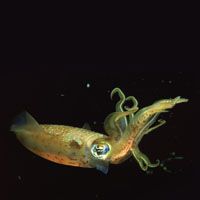Tentacles of fury
A pheromone from female squid has been identified that triggers immediate and dramatic fighting in male squid that touch it.

A pheromone from female squid has been identified that triggers immediate and dramatic fighting in male squid that touch it.
It was first observed in field studies that male long finned squid were visually attracted to eggs laid on the sea floor, and upon contact switched from calm swimming to the highest level of aggressive fighting. To identify the cause of this behaviour, the components of egg samples have been analysed and the results of this study have been published in Current Biology.1
Eggs samples had their components separated and purified using chromatography; male squid were then exposed to the results. The cause was found to be a protein pheromone, produced in the female reproductive tract and embedded in the surface of the eggs. This pheromone was found to be extremely resistant to degradation and even worked when painted onto a glass vial containing squid eggs.
Experiments showed that the first male to touch the eggs became aggressive fastest, leading to dominance by that squid. Dominant males pair with the females and mate more often, giving them greater fertilization success.
The protein, termed Loligo ß-microseminoprotein, shares similarities with other ß-microseminoproteins, also present in human semen and the secretions of other vertebrates, such as rats and boars. While the researchers say the proteins are too different to infer the same effects on vertebrates, this discovery may inspire other researchers to consider the widespread role this gene family may play in sexual competition.
1. S.F. Cummins et al., Current Biology, (In press).
This story originally appeared in The Column. Click here to view that issue.
A Matrix-Matched Semiquantification Method for PFAS in AFFF-Contaminated Soil
Published: April 14th 2025 | Updated: April 14th 2025Catharina Capitain and Melanie Schüßler from the Faculty of Geosciences at the University of Tübingen, Tübingen, Germany describe a novel approach using matrix-matched semiquantification to investigate per- and polyfluoroalkyl substances (PFAS) in contaminated soil.
Silvia Radenkovic on Building Connections in the Scientific Community
April 11th 2025In the second part of our conversation with Silvia Radenkovic, she shares insights into her involvement in scientific organizations and offers advice for young scientists looking to engage more in scientific organizations.











